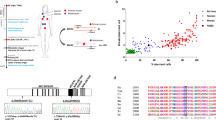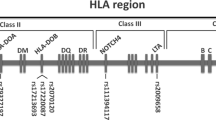Abstract
Therapy-related myelodysplasia and acute myeloid leukemia (t-MDS/AML) is a malignancy occurring after exposure to chemotherapy and/or radiotherapy. Polymorphisms involved in chemotherapy/radiotherapy response genes could be related to an increased risk of developing this neoplasia. We have studied 11 polymorphisms in genes of drug detoxification pathways (NQO1, glutathione S-transferase pi) and DNA repair xeroderma pigmentosum, complementation group (3) (XPC(3), X-ray repair cross complementing protein (1)), Nijmegen breakage syndrome (1), excision repair cross-complementing rodent repair deficiency, complementation group (5) and X-ray repair cross complementing protein (3) and in the methylene tetrahydrofolate reductase gene (MTHFR(2), 677C>T, 1298A>C), involved in DNA synthesis. The analyzed groups were a t-MDS/AML patients group (n=81) and a matched control group (n=64) treated similarly, and they did not develop t-MDS/AML. We found no significant differences when the groups were compared globally. However, when analysis was carried out according to the primary neoplasia involved, a significant association was observed between the MTHFR haplotype (single nucleotide polymorphisms 677 and 1298) and the risk of developing t-MDS/AML in the breast cancer patients group (P=0.016) and cyclophosphamide-treated hematological disease group (P=0.005). Risk haplotype was different for each case, corresponding to the 677T1298A haplotype after breast cancer treatment and the 677C1298C haplotype after hematological malignancy treatment. We postulate that such differences are related to variations in chemotherapy schemes between hematological and breast cancers and their differential interaction with the MTHFR route.
This is a preview of subscription content, access via your institution
Access options
Subscribe to this journal
Receive 12 print issues and online access
$259.00 per year
only $21.58 per issue
Buy this article
- Purchase on Springer Link
- Instant access to full article PDF
Prices may be subject to local taxes which are calculated during checkout
Similar content being viewed by others
References
Smith SM, Le Beau MM, Huo D, Karrison T, Sobecks RM, Anastasi J et al. Clinical-cytogenetic associations in 306 patients with therapy-related myelodysplasia and myeloid leukemia: the University of Chicago series. Blood 2003; 102: 43–52.
Pedersen-Bjergaard J, Christiansen DH, Desta F, Andersen MK . Alternative genetic pathways and cooperating genetic abnormalities in the pathogenesis of therapy-related myelodysplasia and acute myeloid leukemia. Leukemia 2006; 20: 1943–1949.
Rund D, Ben-Yehuda D . Therapy-related leukemia and myelodysplasia: evolving concepts of pathogenesis and treatment. Hematology 2004; 9: 179–187.
Turker A, Guler N . Therapy related acute myeloid leukemia after exposure to 5-fluorouracil: a case report. Hematol Cell Ther 1999; 41: 195–196.
Perentesis JP . Genetic predisposition and treatment-related leukemia. Med Pediatr Oncol 2001; 36: 541–548.
Seedhouse C, Bainton R, Lewis M, Harding A, Russell N, Das-Gupta E . The genotype distribution of the XRCC1 gene indicates a role for base excision repair in the development of therapy-related acute myeloblastic leukemia. Blood 2002; 100: 3761–3766.
Allan JM, Wild CP, Rollinson S, Willett EV, Moorman AV, Dovey GJ et al. Polymorphism in glutathione S-transferase P1 is associated with susceptibility to chemotherapy-induced leukemia. Proc Natl Acad Sci USA 2001; 98: 11592–11597.
Larson RA, Wang Y, Banerjee M, Wiemels J, Hartford C, Le Beau MM et al. Prevalence of the inactivating 609C → T polymorphism in the NAD(P)H:quinone oxidoreductase (NQO1) gene in patients with primary and therapy-related myeloid leukemia. Blood 1999; 94: 803–807.
Mohrenweiser HW, Xi T, Vazquez-Matias J, Jones IM . Identification of 127 amino acid substitution variants in screening 37 DNA repair genes in humans. Cancer Epidemiol Biomarkers Prev 2002; 11 (10, Part 1): 1054–1064.
Brem R, Hall J . XRCC1 is required for DNA single-strand break repair in human cells. Nucleic Acids Res 2005; 33: 2512–2520.
Hayes JD, Pulford DJ . The glutathione S-transferase supergene family: regulation of GST and the contribution of the isoenzymes to cancer chemoprotection and drug resistance. Crit Rev Biochem Mol Biol 1995; 30: 445–600.
Sasai Y, Horiike S, Misawa S, Kaneko H, Kobayashi M, Fujii H et al. Genotype of glutathione S-transferase and other genetic configurations in myelodysplasia. Leuk Res 1999; 23: 975–981.
Woo MH, Shuster JJ, Chen C, Bash RO, Behm FG, Camitta B et al. Glutathione S-transferase genotypes in children who develop treatment-related acute myeloid malignancies. Leukemia 2000; 14: 232–237.
Davies SM, Robison LL, Buckley JD, Tjoa T, Woods WG, Radloff GA et al. Glutathione S-transferase polymorphisms and outcome of chemotherapy in childhood acute myeloid leukemia. J Clin Oncol 2001; 19: 1279–1287.
Naoe T, Takeyama K, Yokozawa T, Kiyoi H, Seto M, Uike N et al. Analysis of genetic polymorphism in NQO1, GST-M1, GST-T1, and CYP3A4 in 469 Japanese patients with therapy-related leukemia/myelodysplastic syndrome and de novo acute myeloid leukemia. Clin Cancer Res 2000; 6: 4091–4095.
Robien K, Ulrich CM . 5,10-Methylenetetrahydrofolate reductase polymorphisms and leukemia risk: a HuGE minireview. Am J Epidemiol 2003; 157: 571–582.
de Jonge R, Hooijberg JH, van Zelst BD, Jansen G, van Zantwijk CH, Kaspers GJ et al. Effect of polymorphisms in folate-related genes on in vitro methotrexate sensitivity in pediatric acute lymphoblastic leukemia. Blood 2005; 106: 717–720.
Etienne MC, Formento JL, Chazal M, Francoual M, Magne N, Formento P et al. Methylenetetrahydrofolate reductase gene polymorphisms and response to fluorouracil-based treatment in advanced colorectal cancer patients. Pharmacogenetics 2004; 14: 785–792.
Khan SG, Muniz-Medina V, Shahlavi T, Baker CC, Inui H, Ueda T et al. The human XPC DNA repair gene: arrangement, splice site information content and influence of a single nucleotide polymorphism in a splice acceptor site on alternative splicing and function. Nucleic Acids Res 2002; 30: 3624–3631.
Brunning RD, Matutes E, Harris NL, Flandrin G, Vardiman J, Bennett JM et al. Acute myeloid leukaemia: introduction. In: Jaffe ES HN, Stein H, Vardiman JW (eds) World Health Organization Classification of Tumours Pathology and Genetics of Tumours of Haematopoietic and Lymphoid Tissues. IARC Press: Lyon, 2001, pp 77–80.
Matullo G, Palli D, Peluso M, Guarrera S, Carturan S, Celentano E et al. XRCC1, XRCC3, XPD gene polymorphisms, smoking and (32)P-DNA adducts in a sample of healthy subjects. Carcinogenesis 2001; 22: 1437–1445.
Sturgis EM, Castillo EJ, Li L, Zheng R, Eicher SA, Clayman GL et al. Polymorphisms of DNA repair gene XRCC1 in squamous cell carcinoma of the head and neck. Carcinogenesis 1999; 20: 2125–2129.
Sole X, Guino E, Valls J, Iniesta R, Moreno V . SNPStats: a web tool for the analysis of association studies. Bioinformatics 2006; 22: 1928–1929.
Schaid DJ, Rowland CM, Tines DE, Jacobson RM, Poland GA . Score tests for association between traits and haplotypes when linkage phase is ambiguous. Am J Hum Genet 2002; 70: 425–434.
Ogino S, Wilson RB . Genotype and haplotype distributions of MTHFR677C>T and 1298A>C single nucleotide polymorphisms: a meta-analysis. J Hum Genet 2003; 48: 1–7.
Frosst P, Blom HJ, Milos R, Goyette P, Sheppard CA, Matthews RG et al. A candidate genetic risk factor for vascular disease: a common mutation in methylenetetrahydrofolate reductase. Nat Genet 1995; 10: 111–113.
van der Put NM, Gabreels F, Stevens EM, Smeitink JA, Trijbels FJ, Eskes TK et al. A second common mutation in the methylenetetrahydrofolate reductase gene: an additional risk factor for neural-tube defects? Am J Hum Genet 1998; 62: 1044–1051.
Weisberg IS, Jacques PF, Selhub J, Bostom AG, Chen Z, Curtis Ellison R et al. The 1298A → C polymorphism in methylenetetrahydrofolate reductase (MTHFR): in vitro expression and association with homocysteine. Atherosclerosis 2001; 156: 409–415.
Pejchal R, Campbell E, Guenther BD, Lennon BW, Matthews RG, Ludwig ML . Structural perturbations in the Ala → Val polymorphism of methylenetetrahydrofolate reductase: how binding of folates may protect against inactivation. Biochemistry 2006; 45: 4808–4818.
Lievers KJ, Boers GH, Verhoef P, den Heijer M, Kluijtmans LA, van der Put NM et al. A second common variant in the methylenetetrahydrofolate reductase (MTHFR) gene and its relationship to MTHFR enzyme activity, homocysteine, and cardiovascular disease risk. J Mol Med 2001; 79: 522–528.
Sohn KJ, Croxford R, Yates Z, Lucock M, Kim YI . Effect of the methylenetetrahydrofolate reductase C677T polymorphism on chemosensitivity of colon and breast cancer cells to 5-fluorouracil and methotrexate. J Natl Cancer Inst 2004; 96: 134–144.
Jakobsen A, Nielsen JN, Gyldenkerne N, Lindeberg J . Thymidylate synthase and methylenetetrahydrofolate reductase gene polymorphism in normal tissue as predictors of fluorouracil sensitivity. J Clin Oncol 2005; 23: 1365–1369.
Shrubsole MJ, Shu XO, Ruan ZX, Cai Q, Cai H, Niu Q et al. MTHFR genotypes and breast cancer survival after surgery and chemotherapy: a report from the Shanghai Breast Cancer Study. Breast Cancer Res Treat 2005; 91: 73–79.
Bagley PJ, Selhub J . A common mutation in the methylenetetrahydrofolate reductase gene is associated with an accumulation of formylated tetrahydrofolates in red blood cells. Proc Natl Acad Sci USA 1998; 95: 13217–13220.
Friso S, Choi SW, Girelli D, Mason JB, Dolnikowski GG, Bagley PJ et al. A common mutation in the 5,10-methylenetetrahydrofolate reductase gene affects genomic DNA methylation through an interaction with folate status. Proc Natl Acad Sci USA 2002; 99: 5606–5611.
Taub JW, Matherly LH, Ravindranath Y, Kaspers GJ, Rots MG, Zantwijk CH . Polymorphisms in methylenetetrahydrofolate reductase and methotrexate sensitivity in childhood acute lymphoblastic leukemia. Leukemia 2002; 16: 764–765.
Chiusolo P, Reddiconto G, Casorelli I, Laurenti L, Sora F, Mele L et al. Preponderance of methylenetetrahydrofolate reductase C677T homozygosity among leukemia patients intolerant to methotrexate. Ann Oncol 2002; 13: 1915–1918.
Seidemann K, Book M, Zimmermann M, Meyer U, Welte K, Stanulla M et al. MTHFR 677 (C → T) polymorphism is not relevant for prognosis or therapy-associated toxicity in pediatric NHL: results from 484 patients of multicenter trial NHL-BFM 95. Ann Hematol 2006; 85: 291–300.
Costea I, Moghrabi A, Laverdiere C, Graziani A, Krajinovic M . Folate cycle gene variants and chemotherapy toxicity in pediatric patients with acute lymphoblastic leukemia. Haematologica 2006; 91: 1113–1116.
Stam RW, Hubeek I, den Boer ML, Buijs-Gladdines JG, Creutzig U, Kaspers GJ et al. MLL gene rearrangements have no direct impact on Ara-C sensitivity in infant acute lymphoblastic leukemia and childhood M4/M5 acute myeloid leukemia. Leukemia 2006; 20: 179–182.
Huang Y, Fang Y, Wu J, Dziadyk JM, Zhu X, Sui M et al. Regulation of Vinca alkaloid-induced apoptosis by NF-kappaB/IkappaB pathway in human tumor cells. Mol Cancer Ther 2004; 3: 271–277.
Pickell L, Tran P, Leclerc D, Hiscott J, Rozen R . Regulatory studies of murine methylenetetrahydrofolate reductase reveal two major promoters and NF-kappaB sensitivity. Biochim Biophys Acta 2005; 1731: 104–114.
Acknowledgements
The present study was financially supported by the Spanish Instituto de Salud Carlos III. Networks of groups. FIS G03-008 and PI050763 projects.
Author information
Authors and Affiliations
Corresponding author
Rights and permissions
About this article
Cite this article
Guillem, V., Collado, M., Terol, M. et al. Role of MTHFR (677, 1298) haplotype in the risk of developing secondary leukemia after treatment of breast cancer and hematological malignancies. Leukemia 21, 1413–1422 (2007). https://doi.org/10.1038/sj.leu.2404709
Received:
Revised:
Accepted:
Published:
Issue Date:
DOI: https://doi.org/10.1038/sj.leu.2404709
Keywords
This article is cited by
-
Therapy-related myeloid neoplasms with different latencies: a detailed clinicopathologic analysis
Modern Pathology (2022)
-
A systematic review of inter-individual differences in the DNA repair processes involved in melphalan monoadduct repair in relation to treatment outcomes
Cancer Chemotherapy and Pharmacology (2021)
-
Polymorphisms in MDM2 and TP53 Genes and Risk of Developing Therapy-Related Myeloid Neoplasms
Scientific Reports (2019)
-
Significant association between ERCC2 and MTHR polymorphisms and breast cancer susceptibility in Moroccan population: genotype and haplotype analysis in a case-control study
BMC Cancer (2018)
-
Polymorphisms in the ABCB1 gene and effect on outcome and toxicity in childhood acute lymphoblastic leukemia
The Pharmacogenomics Journal (2015)



